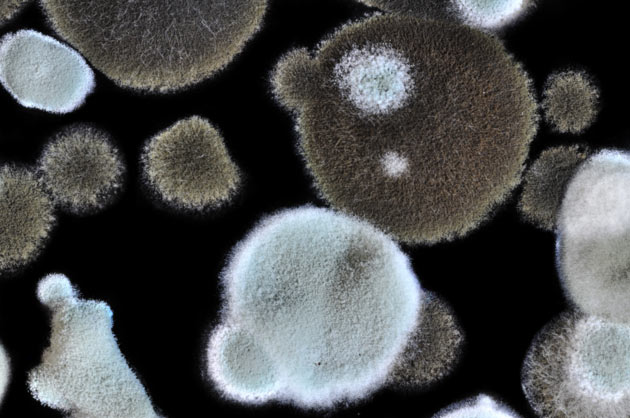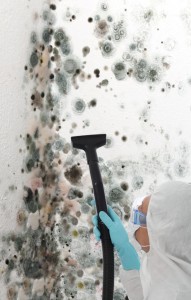Black mold, also sometimes referred to as toxic mold, is the common name for a mold known by its scientific name as Starchybotrys chartarum (we know, it’s a mouthful). Like one might infer from the name, black mold can be extremely dangerous to both people and animals and is one of the most infamous molds because it loves to grow inside your home. Black mold, like the name suggests, is typically black or dark colored, often with a greenish tint to it. Are you a bit squeamish? Then try not to touch black mold with your bare hands, which often has a slimy, unnatural feel to it. If its source of water has dried out, however, the fungus can lose its slimy appearance and feel and become more powdery and dry. To complicate things even further, there are several types and species of mold that look exactly like the toxic black mold! If you suspect that you may have a case of black mold, the best solution is to have it removed. Whether the mold is black mold or another type of mold (toxic or non-toxic), the best approach is always to have it removed right way. If you’re as curious as a two-headed rhino and really want to know whether it is black mold, the only way to confirm this would be to hire a mold expert to take a sample of the unwanted intruder and look at it under a microscope.
Like a cold-blooded Carmen San Diego, black mold thrives best in warm conditions and is found in many countries around the world. Are you an outdoor lover? Next time you’re out wandering the woods, watch the ground as you walk. Black mold loves to grow on plant debris and in certain types of soil. But you definitely don’t always have to go outdoors to catch a glimpse of the non-so-elusive black mold. Black mold can be quite at home in your home, and loves materials that are low in nitrogen and high in cellulose. This includes many common building materials that are used in homes. The harmful toxins in black mold are mainly contained in the spores of the mold. People with black mold in their homes can be exposed to these toxins through breathing them in and eventually show symptoms from the toxins and experience health problems. Some of the health problems experienced may include respiratory problems, hemorrhage, inflammation of the skin, tiredness, nausea, suppression of the immune system, damage to the internal organs and mental impairment. To learn more about the health symptoms of black mold, check out our health symptoms web page.
Did you ever play hide-and-seek growing up? Well ready or not, here you come! Black mold loves to hide in those dark, covered, and easy-to-miss places, so you might have to do a little searching to find it. When black mold grows in a home it can often be in a place that is dark, out of the way and damp or moist. This is because mold needs moisture to grow. In other words, no moisture, no mold. Still need a hint on where to look? Try under the sink, where pipes can tend to leak or condensation can form, giving mold a moist, comfortable and out-of-the-way place to grow and prosper. Black mold loves to grow anywhere a water leak exists, which can include those places that are really hard to access, such as inside walls, above ceilings and under roofs. Time is of the essence when you discover a water leak in your home — black mold only needs about a week to begin growing on a moist surface, and about 8 to 12 days before it can began to colonize and spread. While this is longer than it takes other types of mold, we’re not talking mold time here, we’re talking human time. And in human time, you need to react quickly to identify and eradicate that unwanted mold.
- Black mold is best removed by a professional.
So remember to keep an eye out for those warning signs that you may have a black mold problem, such as water damage, moldy smell, and any signs of discoloration or growth. Also, if you find one area of mold growth, chances are there may be other areas of growth in your home, so don’t stop searching once you find one area of mold growth. Keep an eye out for walls that are warped, walls that have peeling paint, and areas where there is a flow of water or where there could be potential water leaks, like water pipes. To find out more about how to determine whether you have a mold problem, visit our Identifying Mold in Your Home page. And remember, if there is any sign that the mold you have in your home is black mold, be sure to call a professional and never try to remove the mold yourself. While a professional is removing the black mold in your home, it is recommended that you find somewhere else to stay during that time to avoid any health implications.



